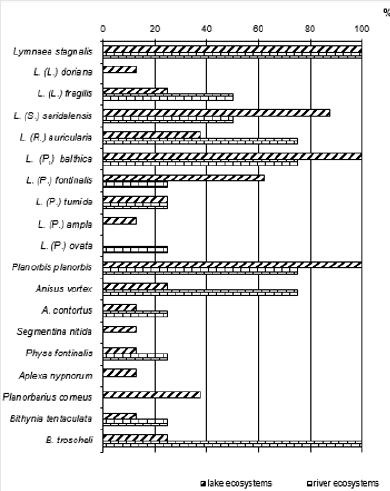Earth and Environment journals | Lupine Publishers
Abstract
Introduction
Materials and Methods
The hydrological and hydrochemical characteristics of the rivers and lakes in steppe zone in the West - Siberian Plain are presented in the study by Savchenko (2010). The study was based at the Karasuk Field Station (Institute of Systematics and Ecology of Animals Russian Academy of Sciences; Karasukskii district, Novosibirsk region). Mollusks were collected according to the standard technique [8]. For a quantitative analysis of snails in the lake-river systems they were collected by hand from sites of 0.25 m2 (50х50 cm). The control sites were in open parts and in macrophyte stands at a depth of 0.1-1.1 m. To determine biomass, the collected mollusks were dried on a filter paper for ≥1 min and weighed. The species identification was made according to the shell and genital system using the keys [9,10]. The ICA index (index of copulatory apparatus) was one of the major criteria for the species definition of mollusks. The species definition within the Lymnaeidae index for mature specimens into account [6].
Results
Species Composition of Gastropods
In the Karasuk river - lakes system, of 21 species from 7 families of gastropods were recorded: Pond Snail - [Lymnaeidae]; Lymnaea (Radix) auricularia (L.,1758), L. (Peregriana) balthica (L., 1758); L. (P.) fontinalis (Studer, 1820), L. (P.) ovata (Drap., 1805), L. (P.) ampla (Hartmann, 1821), L. (P.) tumida (Held, 1836), and Lymnaea (Stagnicola) saridalensis (Mozley, 1934) and Great Pond Snails (Lymnaea) stagnalis (L., 1758), L. (L.) fragilis (L., 1758), L. (L.) doriana (Bourguignat, 1862); Ramshorn snails, Planorbis planorbis (L., 1758), Anisus vortex (L., 1758), A. contortus (L.,1758), Segmentina nitida (Mull., 1774) [Planorbidae], and Planorbarius corneus (L., 1758) [Bulinidae]; Physa fontinalis (L., 1758), Aplexa nypnorum (L., 1758) [Physidae]; Bithynia tentaculata (L., 1758) and B. troscheli (Paasch, 1842) [Bithyniidae]. Terrestrial gastropods were defined by genus, Succinea sp. [Succineidae] and Zonitoides sp. [Zonitidae].
Table 1: Abundance and biomass of gastropods and the Shannon index in water objects from the Karasuk system.

Sixteen gastropod species were recorded in the river and 20 in
the lakes (Figure 1). Fifteen species were common for both the river
and the lakes. The snails L. (P.) ovata were found in the river only and
five species were found only in the lakes: (L. (L.) doriana and L. (P.)
ampla, only in the Astrodym lake; S. nitida only in the Krotovo lake;
A. nypnorum only in the Melkoye lake). Ramshorn snails P. corneus
were found in the Krivoye Krotovo and Titovo lakes. Gastropoda in
modern freshwater water bodies (the steppe zone West Siberian
Plain) are represented by Pulmonata and Prosobranchia species.
Both secondary aquatic pulmonate snails (four families) and
terrestrial species (two families) were recorded in the study area.
The terrestrial snails inhabit plants that grow close to the water’s
edge and appear in the samples of aquatic species. Prosobranchia
snails are primarily aquatic; they are the most ancient colonizers
of the continental water bodies and are represented by only one
family, Bithyniidae. Both bithyniid snails were recorded only in the
upper stream of the Karasuk River (close to Bystrukha Village) and
in Krotovo Lake [11].
Assessment of the Abundance and Biomass of Gastropods
The abundance of snails in the river varied from 10 up to 192 ind./m2 (Table 1). Lymnaeidae snails dominated, followed by Bithyniidae snails were sub-dominants. The Shannon-Weaver index, as calculated under the gastropod population density, indicated an increase of the species diversity from 1.4-1.5 bit/ind. (upper stream) up to 1.8-1.9 bit/ind. (lower stream). The maximum abundance of snails in the lakes varied from 49 up to 400 ind./m2. (Blagodatnoye reach and Melkoye). In lakes the Shannon-Weaver index varied from 0.56 bit/ind. (Kusgan) up to 1.9 bit/ind. (Titovo; Sopatoye reach). The maximum biomass of gastropods in the river varied from 21.7 to 142.9 g/m2; or in lakes from 9.4 to 369.8 g/ m2 (Blagodatnoye reach and Melkoye). Lymnaeidae snail’s biomass were dominated by, both in the river and in the lakes [12,13]. It should be mentioned that high abundance did not always correlate with high biomass. Thus, the high abundance (192 ind./m2) of L. stagnalis corresponded to the biomass 1.26 g/ m2, which can be explained by the prevalence of young snails in the samples. Although an adult L. stagnalis can weigh 4.9 grams.Twenty-one species of snails belonging to seven families were recorded, Lymnaeidae, Planorbidae. Bulinidae, Physidae, Bithynhdae, Succineidae, and Zonitidae. All the recorded mollusk species are common in water bodies that are characterized by slow cur rents, in stagnant (mostly perennial) and semilotic water pools; they are common species in the southern part of Western Siberia. Lymnaeidae snail’s biomass were dominated by, both in the river and in the lakes.
For more Lupine Publishers Open Access Journals Please visit our website:
https://lupinepublishersgroup.com/
For more Earth and Environment Journals Please Click Here: https://lupinepublishers.com/environmental-soil-science-journal/
To Know More About Open Access Publishers Please Click on Lupine Publishers


No comments:
Post a Comment
Note: only a member of this blog may post a comment.